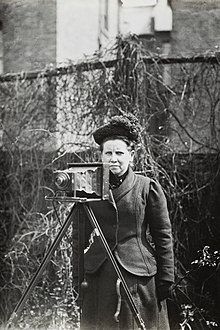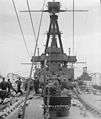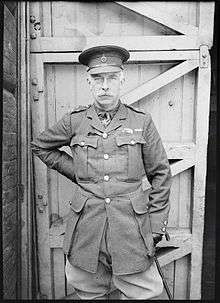Christina Broom
Christina Broom (née Livingston; 28 December 1862 – 5 June 1939) was a Scottish photographer, credited as "the UK's first female press photographer".[1][2]
Christina Broom | |
|---|---|
 Christina Broom, aka Mrs Albert Broom | |
| Born | Christina Livingston 28 December 1862 Chelsea, London, England |
| Died | 5 June 1939 (aged 76) |
| Occupation | Photographer |
| Years active | 1904 - 1939 |
| Known for | UK's first female press photographer |
| Movement | Photographer of suffragette movement in England |
| Spouse(s) | Albert Broom |
| Children | Winifred Margaret Broom |
History
Christina Livingston's parents were Scottish though she was born at 8 King's Road, Chelsea, London, the seventh of eight children. Her father was Alexander Livingston (1812-1875), a master bootmaker and her mother Margaret Fair (1826-1884).[2] She married Albert Edward Broom (1864–1912) in 1889. They had a daughter Winifred Margaret, born 7 August 1890 born at their home in Napier Avenue, Fulham.[3][4] In 1903, following the failure of the family ironmongery business and other business ventures, perhaps as Albert had been injured in a cricket match, with damage to the bone in his shin in 1896, which did not heal,[4] they opened a stationery shop in Streatham which folded, for example.[4]
Then needing a source of income, Broom borrowed a box camera and taught herself the rudiments of photography. She set up a stall in the Royal Mews at Buckingham Palace, selling postcards of photographs that she had taken. She maintained this stall from 1904 until 1930.[1][2]
When the family moved to Burnfoot Avenue, she used the coal cellar as her dark room. She was assisted by Winifred, her daughter, who had left school to assist her mother; Albert wrote the captions for the postcards in his neat script. The postcards sold well: in one night-time session Broom printed 1,000.[2]
Broom was appointed official photographer to the Household Division from 1904 to 1939 and had a darkroom in the Chelsea Barracks; she also took many photographs of local scenes, including those at the Palace, as well as The Boat Race and Suffragette marches. It is not known if she sympathised with the demand for women's suffrage, indeed it may be that Broom saw the historical importance of recording the events rather than taking part in them,[5] but she took publicity pictures of Women's Sunday in 1908, and the mass march on 23 July 1910, when 10,000 women gathered, and the Irish group dressed in green, and on 26 July 1913, women 'pilgrims' who had walked from Carlisle to London to support the moderate suffragists.[6] Broom took pictures of suffragettes at events and marches and more informal shots throughout their campaign.[7] She took images of the local Church pageant in Fulham in 1909 and the Army pageant in Fulham Palace grounds in 1910.[8]
Albert died in 1912 and Christina and Winifred moved to Munster Road, Fulham. Broom took the professional name of Mrs Albert Broom. Christina and Winifred continued to photograph notable buildings, and people in informal and formal scenes,[3] outdoors, a rare sight given the amount of equipment needed.[9] Broom's health was affected by severe backpain and Winnie had to sometimes push her in a wheelchair to the Barracks to do her work.[3]
In the 1920s and 1930s her work was featured in publications such as the Daily Sketch [10], the Illustrated London News, The Tatler, The Sphereand Country Life.[2] She took pictures of royal horses and of events and everyday life as well as her Army and official royal reportage.
Christina and Winifred were themselves photographed at the Mayor's reception, Fulham Town Hall in 1934, and at The Boat Race in 1936. [4] Broom was last pictured relaxing, fishing in Margate shortly before her death. [5]
Death and legacy
Broom died on 5 June 1939, she was buried in Fulham old cemetery.[2] Winifred was instrumental in safeguarding Christina's negatives by having them housed in public institutions.[3] Queen Mary, a photographer herself, said they were ’for posterity where people may go and look at prints when they have more leisure.’ [8]
In 36 years of work Broom took 40,000 images altogether.[7]
Collections of Broom's photographs are held at the Museum of London, the National Portrait Gallery, the Imperial War Museum, London, the National Museum of Scotland, Edinburgh, the Royal Maritime Museum, Greenwich, the Guards Museum, London; the Royal Borough of Kensington and Chelsea Local Studies Library; the Hammersmith and Fulham Archive and the National Army Museum; Maidstone Art Gallery, Kent; and the Harry Ransom Center and the Gernsheim Collection, University of Texas, both at Austin, Texas, United States.[2]
Some of her work was on show in the National Portrait Gallery in 1994 [3] as part of the exhibition Edwardian Women Photographers.[11]
On 17 December 2009 a collection of some 2,000 of her photographs, mainly of military subjects, was to be offered for sale by auction at Sotheby's in London. The collection was expected to make up to £35,000.[1] It failed to sell and was acquired privately by the Museum of London.[12] In June 2015, the museum opened an exhibition of her photographs entitled Soldiers and Suffragettes.[13] Commentators noted the quality of the images [3] printed from the original plates, as a testament to Christina Broom, a bold self-taught photographer's eye for an image.[4]
The University of Birmingham referenced Broom's work within a 2017 retrospective on Käthe Buchler, a female German photographer, capturing life at home, during World War One.[14]
Some photographs
 Suffragette in costume (1909)
Suffragette in costume (1909) HMS Bellerophon
HMS Bellerophon Life Guards (1914)
Life Guards (1914) Adolphus Cambridge
Adolphus Cambridge
Further reading
- Atkinson, D., Mrs Broom's Suffragette Photographs (1990)
- Inselmann, A. (ed.), A Second Look (1993)
References
- Andrew Levy (17 December 2009). "Images of Great War's lost generation preparing to head off to the Western Front - captured by the UK's first female Press photographer". Daily Mail. London. Retrieved 16 December 2009.
- Neale, Shirley (2004). "Broom (née Livingston), Christina (known as Mrs Albert Broom) (1862–1939), photographer". Oxford Dictionary of National Biography. doi:10.1093/ref:odnb/54345. Retrieved 16 December 2009.
- Anna Sparham; Margaret Denny; Diane Atkinson (2015). Soldiers and Suffragettes: The Photography of Christina Broom. Philip Wilson Publishers. pp. 228, 229. ISBN 978-1781300381.
- Libraries, LBHF (7 August 2015). "Christina Broom: the first female press photographer". LBHF Libraries. Retrieved 22 November 2019.
- "A Look at the Suffrage Movement With the UK's First Female Photojournalist". Hyperallergic. 14 July 2015. Retrieved 22 November 2019.
- Atkinson, Diane (2018). Rise up, women! : the remarkable lives of the suffragettes. London: Bloomsbury. pp. 257, 431. ISBN 9781408844045. OCLC 1016848621.
- "Meet the photo pioneer finally getting the exposure she deserves". The Independent. 6 June 2015. Retrieved 22 November 2019.
- "Christina Bloom". The Fulham and Hammersmith Historical Society. Retrieved 22 November 2019.
- Broom, Christina, 1862-1939. (31 December 1988). Mrs Broom's suffragette photographs : photographs by Christina Bloom, 1908 to 1913. Atkinson, Diane,, Nishen (Firm). London. ISBN 1-85378-110-X. OCLC 20723454.CS1 maint: multiple names: authors list (link)
- "Aesthetica Magazine - Soldiers and Suffragettes: the Photography of Christina Broom, Museum of London Docklands, London". Aesthetica Magazine. Retrieved 22 November 2019.
- "Edwardian Women Photographers: Eveleen Myers, Alice Hughes, Christina Broom and Olive Edis". National Portrait Gallery. Retrieved 23 March 2020.
- http://britishphotohistory.ning.com/profiles/blogs/exhibition-christina-broom-britain-s-first-female-press-photograp Accessed 27 April 2014
- "What's on - events & exhibitions | Museum of London Docklands". Museum of London.
- "'Beyond the Battlefields' at University of Birmingham and Birmingham Museum and Art Gallery – Midlands Art Papers". blog.bham.ac.uk. Retrieved 22 November 2019.
External links
| Wikimedia Commons has media related to Christina Broom. |